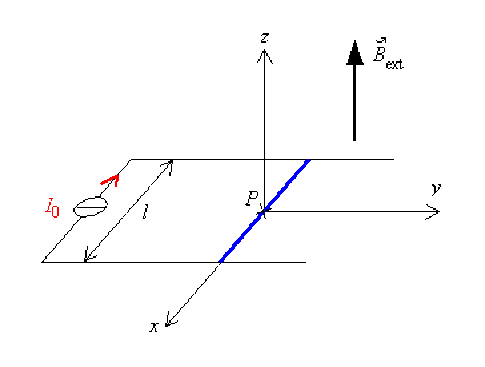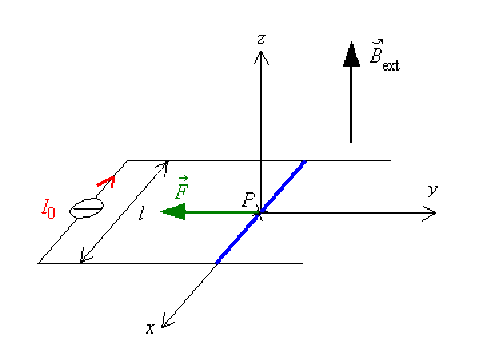Tige conductrice soumise à la force de Laplace
Partie
Question
Une tige rigide conductrice rectiligne (bleue) est placée sur deux rails conducteurs parallèles distants de \(l\).
Un générateur de courant continu \(I_0\) est branché aux extrémités des deux rails. L'ensemble est placé dans un champ magnétique extérieur \(\vec B_{\mathrm{ext}}\) constant, uniforme et perpendiculaire au plan des deux rails. L'espace est rapporté à un référentiel orthonormé direct \((O ; x, y, z)\).

Déterminer la force de Laplace exercée sur la tige.
De quel côté se déplace la tige ?
Aide simple
L'élément de courant linéique \(I_0\vec{\mathrm{d}l}\) au point \(P\) est porté par l'axe des \(x\) et dirigé suivant les \(x > 0\) dans le domaine \(\mathcal D\) constitué par la tige conductrice.
Rappel de cours
Le produit scalaire :
\(\vec A.\vec B=\left(\begin{array}{c} A_1\\A_2\\A_3\end{array} \right)_{\mathcal{B}} . \left(\begin{array}{c} B_1\\B_2\\B_3\end{array} \right)_{\mathcal{B}} =A_1B_1+A_2B_2+A_3B_3\)
Le produit vectoriel :
\(\vec A\wedge\vec B=\left(\begin{array}{c} A_1\\A_2\\A_3\end{array} \right)_{\mathcal{B}} \wedge\left(\begin{array}{c} B_1\\B_2\\B_3\end{array} \right)_{\mathcal{B}} =\left(\begin{array}{c} A_2B_3-A_3B_2\\A_3B_1-A_1B_3\\A_1B_2-A_2B_1\end{array} \right)_{\mathcal{B}}\)
Les opérateurs vectoriels :
Système de repérage cartésien \(\mathcal{B}_{\mathrm{cart.}}(\vec{e_x}, \vec{e_y}, \vec{e_z})\)
gradient : \(\vec{\mathrm{grad}}U\) | divergence : \(\mathrm{div}\vec A\) | rotationnel : \(\vec{\mathrm{rot}}\vec A\) |
\(\left(\begin{array}{c} \displaystyle{ \frac{\partial U}{\partial x} } \\ \displaystyle{ \frac{\partial U}{\partial y} } \\ \displaystyle{ \frac{\partial U}{\partial z} } \end{array} \right)_{\mathcal{B}_{\mathrm{cart.}}}\) | \(\displaystyle{ \frac{\partial A_x}{\partial x}+\frac{\partial A_y}{\partial y}+\frac{\partial A_z}{\partial z} }\) | \(\left(\begin{array}{c} \displaystyle{ \frac{\partial A_z}{\partial y}-\frac{\partial A_y}{\partial z} } \\ \displaystyle{ \frac{\partial A_x}{\partial z}-\frac{\partial A_z}{\partial x} } \\ \displaystyle{ \frac{\partial A_y}{\partial x}-\frac{\partial A_x}{\partial y} }\end{array} \right)_{\mathcal{B}_{\mathrm{cart.}}}\) |
Système de repérage cylindrique \(\mathcal B_{\mathrm{cyl.}}(\vec{e_r},\vec{e_{\theta}},\vec{e_z})\)
gradient : \(\vec{\mathrm{grad}}U\) | divergence : \(\mathrm{div}\vec A\) | rotationnel : \(\vec{\mathrm{rot}}\vec A\) |
\(\left(\begin{array}{c} \displaystyle{ \frac{\partial U}{\partial r} } \\ \displaystyle{ \frac{1}{r} \frac{\partial U}{\partial \theta} }\\ \displaystyle{ \frac{\partial U}{\partial z} } \end{array} \right)_{\mathcal{B}_{\mathrm{cyl.}}}\) | \(\displaystyle{ \frac{1}{r} \frac{\partial (r . A_r) }{\partial r} + \frac{1}{r} \frac{\partial A_{\theta}}{\partial \theta}+\frac{\partial A_z}{\partial z} }\) | \(\left(\begin{array}{c} \displaystyle{ \frac{1}{r} \frac{\partial A_z}{\partial \theta}-\frac{\partial A_ \theta}{\partial z} } \\ \displaystyle{ \frac{\partial A_r}{\partial z}-\frac{\partial A_z}{\partial r} } \\ \displaystyle{ \frac{1}{r} \left( \frac{\partial (r. A_{\theta})}{\partial r}-\frac{\partial A_r}{\partial \theta} \right)} \end{array} \right)_{\mathcal{B}_{\mathrm{cyl.}}}\) |
Nom de l'outil | Comment s'énonce-t-il ? | Quand l'utiliser ? |
Théorème d'Ampère | \(\displaystyle{ \oint_{\mathcal C}\vec B.\vec{\mathrm{d}l}=\mu_0\sum I }\) | Pour calculer \(\vec B\) si la géométrie du problème permet un calcul simple de la circulation de \(\vec B\). |
Loi de Biot et Savart | \(\displaystyle{ \vec B(M)=\frac{\mu_0}{4\pi}\int_{\mathcal D}\vec{\mathrm{d} \mathcal C}(P)\wedge\frac{\vec{PM}}{PM^3} }\) | Pour calculer \(\vec B\) si la géométrie de la distribution ne permet pas une application simple du théorème d'Ampère. |
Relation champ magnétostatique/ potentiel vecteur | \(\vec{B}(M)=\vec{\mathrm{rot}}\vec A(M)\) | Pour calculer \(\vec B\) si \(\vec A\) est connu. |
Définition de la force de Laplace | \(\vec{F_m}=\displaystyle{ \int_{\mathcal D}\vec{\mathrm{d} \mathcal C}(P)\wedge\vec B_{\mathrm{ext}}(P) }\) | Pour calculer la force qui s'exerce sur une distribution \(\mathcal D\) soumise à un champ magnétostatique extérieur \(\vec B_{\mathrm{ext}}\) |
Théorème de Maxwell | \(W_{2\leftarrow1}=I . \Phi_c\) | Pour calculer directement le torseur des forces qui agissent sur un circuit. |
Définition du potentiel vecteur | \(\displaystyle{ \vec A(M)=\int_{\mathcal D}\frac{\mu_0}{4\pi}\frac{\vec{\mathrm{d}\mathcal C}(P)}{PM} }\) | Pour calculer \(\vec A\) si la distribution a un haut degré de symétrie. |
Solution détaillée
La force de Laplace peut être déterminée à partir de l'expression :
\(\displaystyle{ \vec F=\int_{\mathcal D}I_0\vec{\mathrm{d}l}(P)\wedge\vec B_{\mathrm{ext}}(P) }\).
C'est la force à laquelle est soumis ce circuit.
Exprimons \(I_0\vec{\mathrm{d}l}(P)\) et \(\vec B_{\mathrm{ext}}\) dans la base \(\mathcal B=(\vec{e_x},\vec{e_y},\vec{e_z})\) :
\(I_0\vec{\mathrm{d}l}(P)=\left(\begin{array}{c} I_0 \mathrm{d}l\\0\\0 \end{array}\right)\quad\vec B_{\mathrm{ext}}(P)=\left(\begin{array}{c}0\\0\\B\end{array}\right)\)
Calculons le produit vectoriel :
\(I_0\vec{\mathrm{d}l}(P)\wedge\vec B_{\mathrm{ext}}(P)=\left(\begin{array}{c} I_0\mathrm{d}l\\0\\0 \end{array}\right)\wedge\left(\begin{array}{c}0\\0\\B\end{array}\right)=\left(\begin{array}{c} 0\\-I_0\mathrm{d}l.B\\0\end{array}\right)=-I_0\mathrm{d}l.B.\vec{e_y}\)
Nous devons maintenant intégrer sur le domaine \(\mathcal{D}\) correspondant à la tige de longueur \(l\).
\(\displaystyle{ \vec F=\int_l-I_0\mathrm{d}l.B.\vec{e_y}=-I_0 l.B.\vec{e_y} }\)

La tige se déplace vers les y < 0.